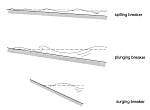Chapter 2: The impact of the sea
2.2 Waves (3)

| European Coasts - An Introductory Survey Chapter 2: The impact of the sea 2.2 Waves (3) |
|
 |
 |
 |
| Fig 42: Types of breaking waves | Fig 43: Spilling breakers at the beach of Zandvoort, the Netherlands | Fig 44: Plunging breaker (at the right side of the photo), the Netherlands |
Breaking waves
Wave characteristics are affected if the wave approaches the shore: the shoaling effect. The changes in wave properties due to this shoaling effect will be discussed in future courses on waves.
Waves are limited in their height. Waves that become "too high" will break. What is too high? Waves break if the relative wave height (the ratio of wave height to water depth) becomes too large or if the wave steepness
(the ratio of wave height to wave length) is too large. The theoretical limit for the wave height to water depth
ratio is 0.78 for relatively flat sea beds (a more practical value is 0.6). The theoretical limit to wave steepness
is 1:7 (more realistically, 1:10).
Types of breakers
Due to wave breaking, the wave height decreases. Part of the wave energy is dissipated into sound (listen at the coast!), friction and turbulence, part of the energy is reflected and part proceeds in the smaller remaining
wave. Depending on the bottom slope, three types of breakers occur in the surf zone (see Fig. 42). On very flat
beaches, spilling breakers are found (see Fig. 43). The waves break gradually over a very long distance. On steep shores, the more spectacular plunging breakers can be seen (see Fig. 1 and Fig. 44). The waves break
with the crest curling over in one short impressive motion. On extremely steep slopes, such as rocky shores, surging breakers can occur. In this case, the wave is reflected before the top can curl over.
previous page table of contents next page
| This page is from the book "European Coasts", produced in the framework of the Erasmus project under EC contract ICP 92-G-2013 and placed on the Internet in the framework of the PIANC-MarCom initiative on Education. |